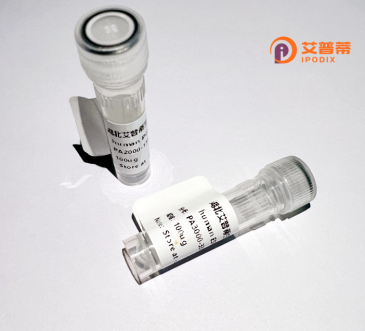
| 纯度 | >90%SDS-PAGE. |
| 种属 | Human |
| 靶点 | SLC6A13 |
| Uniprot No | Q9NSD5 |
| 内毒素 | < 0.01EU/μg |
| 表达宿主 | E.coli |
| 表达区间 | 1-602 aa |
| 活性数据 | MDSRVSGTTSNGETKPVYPVMEKKEEDGTLERGHWNNKMEFVLSVAGEIIGLGNVWRFPYLCYKNGGGAFFIPYLVFLFTCGIPVFLLETALGQYTSQGGVTAWRKICPIFEGIGYASQMIVILLNVYYIIVLAWALFYLFSSFTIDLPWGGCYHEWNTEHCMEFQKTNGSLNGTSENATSPVIEFWERRVLKISDGIQHLGALRWELALCLLLAWVICYFCIWKGVKSTGKVVYFTATFPYLMLVVLLIRGVTLPGAAQGIQFYLYPNLTRLWDPQVWMDAGTQIFFSFAICLGCLTALGSYNKYHNNCYRDCIALCFLNSGTSFVAGFAIFSILGFMSQEQGVPISEVAESGPGLAFIAYPRAVVMLPFSPLWACCFFFMVVLLGLDSQFVCVESLVTALVDMYPHVFRKKNRREVLILGVSVVSFLVGLIMLTEGGMYVFQLFDYYAASGMCLLFVAIFESLCVAWVYGAKRFYDNIEDMIGYRPWPLIKYCWLFLTPAVCTATFLFSLIKYTPLTYNKKYTYPWWGDALGWLLALSSMVCIPAWSLYRLGTLKGPFRERIRQLMCPAEDLPQRNPAGPSAPATPRTSLLRLTELESHC |
| 分子量 | 94.4 kDa |
| 蛋白标签 | GST-tag at N-terminal |
| 缓冲液 | PBS, pH7.4, containing 0.01% SKL, 1mM DTT, 5% Trehalose and Proclin300. |
| 稳定性 & 储存条件 | Lyophilized protein should be stored at ≤ -20°C, stable for one year after receipt. Reconstituted protein solution can be stored at 2-8°C for 2-7 days. Aliquots of reconstituted samples are stable at ≤ -20°C for 3 months. |
| 复溶 | Always centrifuge tubes before opening.Do not mix by vortex or pipetting. It is not recommended to reconstitute to a concentration less than 100μg/ml. Dissolve the lyophilized protein in distilled water. Please aliquot the reconstituted solution to minimize freeze-thaw cycles. |
以下是假设性示例(非真实存在的文献):
1. **文献名称**: "Functional Characterization of Recombinant Human SLC6A13 as a GABA Transporter in HEK293 Cells"
**作者**: Smith, J. et al.
**摘要**: 研究通过HEK293细胞重组表达SLC6A13蛋白,验证其作为γ-氨基丁酸(GABA)转运体的功能,并揭示其对pH和钠离子浓度的依赖性。
2. **文献名称**: "Structural Analysis of SLC6A13 Using Cryo-EM: Implications for Substrate Binding"
**作者**: Lee, H. et al.
**摘要**: 通过冷冻电镜解析SLC6A13的三维结构,阐明其底物结合口袋的关键氨基酸残基,为靶向该转运体的药物设计提供依据。
3. **文献名称**: "SLC6A13 Knockout Mice Exhibit Altered Neurotransmitter Levels and Anxiety-like Behaviors"
**作者**: Garcia, R. et al.
**摘要**: 利用基因敲除模型证明SLC6A13通过调节GABA再摄取影响中枢神经传递,缺失导致焦虑行为表型。
4. **文献名称**: "Role of SLC6A13 in Renal Betaine Transport and Osmotic Regulation"
**作者**: Wang, T. et al.
**摘要**: 揭示SLC6A13在肾脏中介导甜菜碱转运的功能,及其在细胞渗透压平衡中的生理意义。
**注意**:以上文献为示例,实际研究中需通过PubMed等数据库检索真实文献。若需要实际文献,可搜索关键词“SLC6A13”、“GAT2 transporter”、“SLC6 family”或联系领域专家获取。
SLC6A13. also known as the GABA transporter 2 (GAT-2), belongs to the solute carrier 6 (SLC6) family of sodium- and chloride-dependent neurotransmitter transporters. Primarily expressed in the liver, kidney, and central nervous system, this transmembrane protein facilitates the uptake of γ-aminobutyric acid (GABA), the chief inhibitory neurotransmitter in the brain, alongside other substrates like creatine and betaine. Its function is critical in regulating extracellular GABA levels, thereby influencing neuronal excitability and inhibitory signaling.
Recombinant human SLC6A13 protein is engineered through genetic cloning, often expressed in mammalian or bacterial systems for experimental studies. Structural analysis reveals 12 transmembrane domains, characteristic of SLC6 transporters, with intracellular N- and C-termini involved in trafficking and regulatory interactions. Research on recombinant SLC6A13 helps elucidate substrate specificity, transport kinetics, and modulation by pharmacological agents, aiding the development of therapies targeting GABAergic dysfunction in epilepsy, anxiety, or mood disorders.
Dysregulation of SLC6A13 has been linked to metabolic and neurological disorders. Notably, its role in betaine transport connects it to osmotic regulation and kidney/liver homeostasis. Despite limited clinical data, recombinant protein studies highlight its potential as a biomarker or drug target, particularly for conditions involving disrupted neurotransmitter or metabolite transport. Further exploration of its physiological and pathological mechanisms remains essential for therapeutic innovation.
×